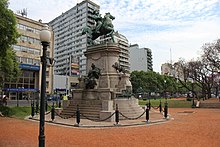Argentina–Italy relations
Argentines of full or partial Italian ancestry number approximately 30 million, or 62% of the country's total population.
[5] The Prince's main visit to Argentina (and other South American nations) was part of a political plan of fascism to link the Italian people living outside of Italy with their mother country.
[6][7] In 1944, due to international pressure, Argentina officially declared war on Germany and Japan as by that time, Italy had already surrendered to the Allies in September 1943.
The relations between the two countries deepened, with the first programs of cooperation in Argentina conducted by the Italian government, led by Bettino Craxi, in 1984 and 1985.
Bipartisan relations started to slow down after the end of Raúl Ricardo Alfonsín's presidency and the explosion of the Tangentopoli scandal.
Then, in the first years of the new century, due to the worsening of the agricultural crisis, the phenomenon expanded to the rest of Italy, including also farmers from the South.
Several Argentine politicians, sports figures, actors, models and literary authors, among others (including the current Catholic Pope), are of Italian descent.
In 2014, ENIT of Buenos Aires promoted the foundation of the "Club Italia Argentina", whose goal is to increase tourist flows.
Deals have regarded a lot of different fields, such as finance, tourism, cultural and scientific collaboration, economic development.
[25] Argentina's main exports to Italy include: wheat, soya beans, frozen crustacean, pears and beef.
Italy's main exports to Argentina include: steam turbines, steel rails, machinery and medicine.
Relations between Argentina and EU started in 1990, when a Framework Trade and Economic Co-operation Agreement[26] entered into force.
[30] The massive migratory phenomena from Italy to Argentina also gave rise to national and regional exchanges between members of civil society, forming a wide net of associations that are still currently visible and active, with over eight hundred entities created by Italians or their descendants to promote the culture and language, provide social assistance, and promote relations between nations.
The main institutions that participate in cultural cooperation are the Italian regional associations in Argentina such as the Istituto Italiano di Cultura de Buenos Aires and Córdoba, the Ufficio Culturale of the Italian Embassy in Argentina, the cultural offices of the Consulates, the Dante Alighieri Association.
One of the main associations is the Societá Dante Alighieri of Buenos Aires, founded in 1896 with the aim of spreading the study of the Italian language and culture to immigrants and their descendants.
Their importance was not just related to the literary field but also to the linguistic one: as Argentina is a country of immigration, its language has always been influenced by all the different incomers, including the Italian ones.
In the second period the journal was dedicated to the reviews of the novels which were, at the same time, translated by Editorial Sur: Alberto Moravia, Vasco Pratolini, Cesare Pavese, etc.
Diego Armando Maradona, one of the biggest football players in history, has had an intense relationship with Naples, the city for which he played and won two championships.
The importance of this relation is not just limited to the football arena; his presence meant a connection between poor social classes of the two countries.



